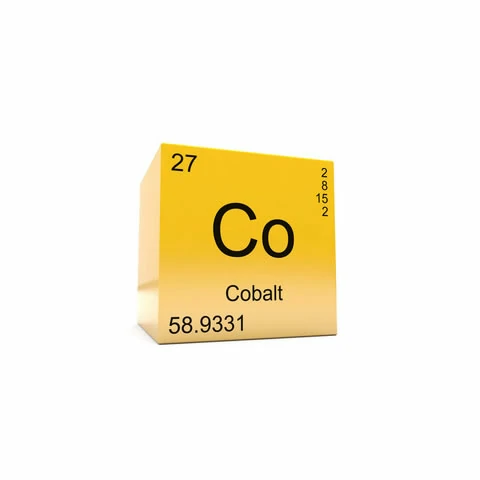Application of Cobalt Element in Power Batteries
2025-05-17
1、 Basic characteristics of cobalt element
Cobalt (Co) is a silver white ferromagnetic metal with the following key characteristics:
Physical properties: high hardness, high tensile strength, melting point of 1495 ℃, density of 8.9g/cm ³, and high temperature stability. Chemical properties: Stable at room temperature, but prone to react with oxygen, sulfur, etc. at high temperatures to form cobalt oxide (CoO) or cobalt trioxide (Co∝ O ₄). Electronic properties: Common valences are+2 and+3, and Co ³ ⁺ plays a role in stabilizing the crystal structure of battery cathode materials.
2、 The core role of cobalt in power batteries
Cobalt is a key component of lithium-ion battery cathode materials, especially playing an irreplaceable role in the following aspects:
Stable crystal structure: Cobalt ions (Co ³ ⁺) occupy specific positions in the layered structure to prevent Li/Ni mixing and ensure smooth migration of lithium ions during charging and discharging. In high nickel materials such as NCM 811, the addition of cobalt can reduce lattice distortion, avoid structural collapse, and prolong battery life. Improving thermal stability: Cobalt reduces the risk of battery thermal runaway and enhances safety by inhibiting oxygen release and minimizing high-temperature phase transitions. Extended cycle life: The oxidation-reduction reaction of cobalt (Co ³ ⁺/Co ⁴⁺) is relatively stable, reducing irreversible capacity loss during charge and discharge processes and maintaining high capacity performance of the battery. Enhanced energy density: Cobalt based cathode materials (such as LiCoO ₂) have a high operating voltage (3.7V), which can significantly improve battery energy density and provide long-lasting power for devices.
3、 Application types of cobalt in power batteries
Cobalt is mainly used as a positive electrode material for the following two types of lithium batteries:
Lithium cobalt oxide (LiCoO ₂): widely used in 3C batteries (smartphones, laptops, etc.), providing high energy density and stability. Ternary materials (NCM/NCA): Nickel cobalt manganese oxide lithium (NCM): such as NCM 523, NCM 811, the cobalt content gradually decreases to reduce costs, but cobalt is still used to stabilize the structure. Lithium nickel cobalt aluminate (NCA): commonly used in Tesla models, cobalt enhances high-temperature stability and cycling performance.
4、 Market Trends and Challenges
Market demand: In the field of new energy vehicles, although the market share of ternary batteries is squeezed by lithium iron phosphate batteries, cobalt is still irreplaceable in high-end car models and long range demand. In the field of consumer electronics, the growth of 5G smartphones and wearable devices is driving the demand for lithium cobalt oxide batteries. Price fluctuations: Cobalt prices will decline in 2024 and are expected to remain low in 2025, mainly due to oversupply (such as increased production in Luoyang Molybdenum Industry) and weak demand (sluggish European and American markets). Technological substitution pressure: The development of cobalt free batteries (such as lithium iron phosphate and solid-state batteries) is accelerating, but the advantages of cobalt in energy density and safety make it difficult to completely replace it in the short term.
5、 Environmental and Social Impact
Environmental impact of mining: Cobalt mining may lead to soil acidification, heavy metal pollution, and water resource destruction, which need to be mitigated through measures such as wastewater treatment and exhaust gas purification. Supply chain risk: Global cobalt resources are concentrated in the Democratic Republic of Congo, and geopolitical and ethical issues such as child labor have raised concerns, prompting companies to strengthen supply chain traceability.
6、 Future prospects
The role of cobalt in power batteries is shifting from 'irreplaceable' to 'efficient utilization':
Material innovation: Reduce cobalt usage through doping, coating and other technologies, such as NCM 9 series (low cobalt). Circular economy: Recycling cobalt from waste batteries to reduce dependence on primary resources. Policy guidance: The global carbon neutrality goal promotes the concentration of cobalt in the clean energy sector, such as energy storage batteries and aviation batteries.

Cobalt element, with its unique physical and chemical properties, has become a key "catalyst" for improving the performance of power batteries. Despite facing cost, supply chain, and environmental challenges, the technological irreplaceability of cobalt will continue to support its core position in the field of new energy in the medium to long term.
Product recommendation:
Electric bicycle frame power battery pack
